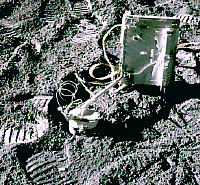
Cold Cathode Ion Gage Experiment
NSSDC ID: 1971-063C-07
Mission Name: Apollo 15 Lunar Module / ALSEP
Principal Investigator: Prof. Francis S. Johnson
Description
The Cold Cathode Gage Experiment (CCGE, also referred to as the Cold Cathode Ion Gage, or CCIG) was deployed as part of the Apollo Lunar Surface Experiments package (ALSEP) on Apollos 12, 14, and 15. It was designed to measure the density of neutral particles to determine the amount of gas present at the lunar surface. This data helps constrain the source and loss mechanisms of the tenuous lunar atmosphere. A cold cathode ionization gage was used for this purpose. The gage can determine the amount of gas present, expressed as concentrations of particles per cubic cm or pressure in torrs, but not its composition. The CCGE gage head was roughly 18 x 10 x 12 cm and used 6.5 W. The instrument consisted of the cold cathode ionization gage and associated electronics.
The CCGE gage unit was carried in a compartment of the SIDE instrument and was removed and set up on the lunar surface by the deploying astronaut. The gage unit was connected by a cable to the SIDE package and attached to the end of the SIDE ground screen holding tube, which was designed to pivot down to the ground and hold the CCGE in place a fixed distance from the SIDE, and with the proper orientation of the gage head. This avoided the difficulties encountered with Apollo 12 and 14 units, where the extreme stiffness and springiness of the electrical cable, plus the low lunar gravity, made it difficult to position the gage head.
The cold cathode ionization gage is a cylindrical sensor unit in a stainless steel envelope consisting of stainless steel coaxial electrodes. The cathode is a spool running through the center axis of the cylinder. A cylindrical anode surrounds the cathode, and both electrodes are in an axial magnetic field of 0.09 Tesla (900 Gauss) produced by a permanent magnet. A magnetic shield is mounted around the gage and its magnet. A potential of +4500 volts was applied to the anode by a power supply consisting of a regulator, convertor, voltage-multiplier network, and feedback network to the low voltage supply. This created a self-sustained Townsend discharge in the gage in which electrons remained largely trapped in the magnetic field with enough energy to ionize any gas particles they would strike. The ions would then be collected at the cathode, producing a current. The cathode was connected to an auto-ranging, auto-zeroing electrometer that measured currents in the range 1.0E-13 to 1.0E-16 amps. A temperature detector was included to enable conversion of the readings to equivalent pressure.
Baffles are mounted in the cylinder between the opening and the electrodes. A dust cover closed but did not seal the opening before deployment and was pulled aside by the squib motor and spring on command. Because the CCGE was not evacuated, adsorbed gases produced an elevated response at turn-on. The gases escaped from the gage rapidly at first and then slowly baked out during the lunar day.
The device was sensitive to gas density rather than pressure. The response varied somewhat with gas composition, but errors due to the uncertainties in composition were expected to be within a factor of two. The data from the experiment have been expressed as equivalent density for a nitrogen lunar atmosphere. The CCGE had three auto-switched, overlapping, sensitivity ranges enabling detection of the lunar atmosphere from 2.E+5 to 1.E+11 particles/cubic cm (equivalent nitrogen). In the normal operational mode the basic cycle repeated five measurements (separated by 2.4 s), three measurements (separated by 40 s), and 16 seconds of calibration and auto-zeroing every 2.5 min. Temperature and other engineering functions were also sampled within this 2.5-min cycle. In a ground commanded special mode, one measurement was obtained every 2.4 s, with no other measurements being performed. More details are available in "Apollo scientific experiments data handbook," NASA TM X-58131, August 1974 (revised April 1976).
The Apollo 15 ALSEP central station was located at 26.1341 N latitude, 3.6298 E longitude. The CCGE was deployed approximately 17 meters east-northeast of the central station and about 100 meters WNW of the Lunar Module. It was turned on at approximately 19:34 UT on 30 July 1971. The unit was operated for short periods of time during LM venting for the second and third EVA, during equipment jettison, and during LM liftoff and was then turned off until lunar sunset. The instrument was left off during lunar daytime to minimize the possibility of high voltage arcing at elevated temperatures. Operation became erratic during lunar nighttime in February 1973 resulting in noisy data. The automatic-zero and calibration functions appeared to stop operating. This problem persisted during all subsequent nighttime operations. On 18 July 1975 the CCGE high voltage was off and could not be commanded on resulting in the termination of the experiment.
Facts in Brief
Mass: 5.7 kg
Power (avg): 6.5 W
Funding Agency
- NASA-Office of Manned Space Flight (United States)
Discipline
- Planetary Science: Atmospheres
Additional Information
Questions or comments about this experiment can be directed to: Dr. David R. Williams.
Personnel
| Name | Role | Original Affiliation | |
|---|---|---|---|
| Prof. Francis S. Johnson | Principal Investigator | University of Texas, Dallas | |
| Dr. Dallas E. Evans | Other Investigator | NASA Johnson Space Center |
Selected References
Johnson, F. S., et al., Cold cathode-gage experiment (lunar-atmosphere detector) - Apollo 15-preliminary science report, NASA, SP-289, 13-1-13-5, Wash., DC, 1972.
Apollo 12 CCGE InstrumentApollo 14 CCGE Instrument and Data
Apollo 15 CCGE Instrument and Data

